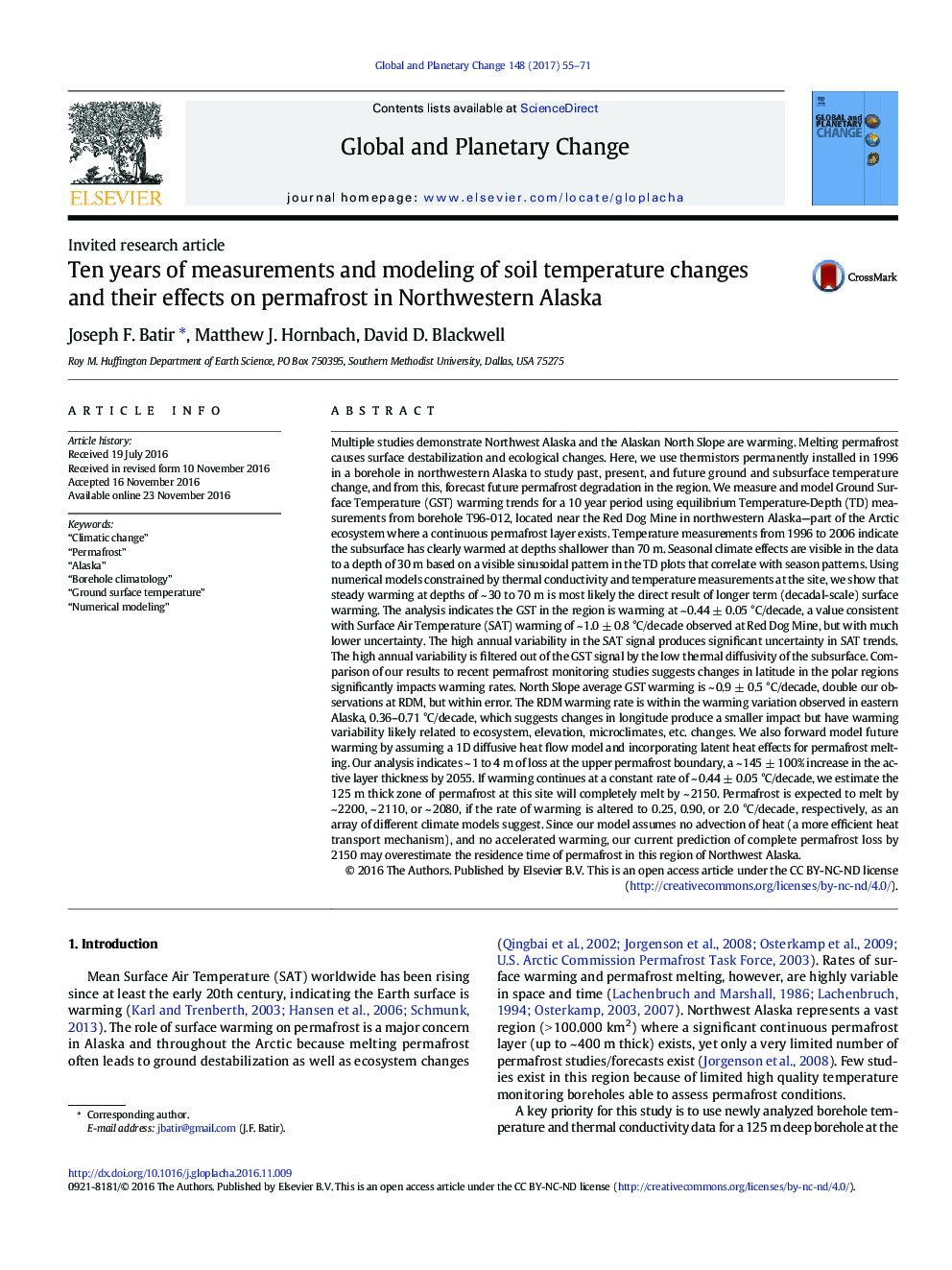| کد مقاله | کد نشریه | سال انتشار | مقاله انگلیسی | نسخه تمام متن |
|---|---|---|---|---|
| 5755354 | 1621634 | 2017 | 17 صفحه PDF | دانلود رایگان |
- Ground Surface Temperature (GST) is warming at ~ 0.44 ± 0.05 °C/decade, in agreement with Surface Air Temperature (SAT) warming in northwestern Alaska, but with significantly lower uncertainty.
- Active layer thickness is forecast to increase by ~ 2.5 ± 2 m (~ 145 ± 100% of original model thickness) by 2055, although there will be minimal to no loss of permafrost at the base of the permafrost layer.
- All permafrost in northwestern Alaska will melt by ~Â 2150 if warming continues at a constant rate.
- The high variability in GST warming in northwestern, northern, and eastern Alaska emphasizes the need for more high spatial and temporal resolution long term local climate change studies.
Multiple studies demonstrate Northwest Alaska and the Alaskan North Slope are warming. Melting permafrost causes surface destabilization and ecological changes. Here, we use thermistors permanently installed in 1996 in a borehole in northwestern Alaska to study past, present, and future ground and subsurface temperature change, and from this, forecast future permafrost degradation in the region. We measure and model Ground Surface Temperature (GST) warming trends for a 10 year period using equilibrium Temperature-Depth (TD) measurements from borehole T96-012, located near the Red Dog Mine in northwestern Alaska-part of the Arctic ecosystem where a continuous permafrost layer exists. Temperature measurements from 1996 to 2006 indicate the subsurface has clearly warmed at depths shallower than 70 m. Seasonal climate effects are visible in the data to a depth of 30 m based on a visible sinusoidal pattern in the TD plots that correlate with season patterns. Using numerical models constrained by thermal conductivity and temperature measurements at the site, we show that steady warming at depths of ~ 30 to 70 m is most likely the direct result of longer term (decadal-scale) surface warming. The analysis indicates the GST in the region is warming at ~ 0.44 ± 0.05 °C/decade, a value consistent with Surface Air Temperature (SAT) warming of ~ 1.0 ± 0.8 °C/decade observed at Red Dog Mine, but with much lower uncertainty. The high annual variability in the SAT signal produces significant uncertainty in SAT trends. The high annual variability is filtered out of the GST signal by the low thermal diffusivity of the subsurface. Comparison of our results to recent permafrost monitoring studies suggests changes in latitude in the polar regions significantly impacts warming rates. North Slope average GST warming is ~ 0.9 ± 0.5 °C/decade, double our observations at RDM, but within error. The RDM warming rate is within the warming variation observed in eastern Alaska, 0.36-0.71 °C/decade, which suggests changes in longitude produce a smaller impact but have warming variability likely related to ecosystem, elevation, microclimates, etc. changes. We also forward model future warming by assuming a 1D diffusive heat flow model and incorporating latent heat effects for permafrost melting. Our analysis indicates ~ 1 to 4 m of loss at the upper permafrost boundary, a ~ 145 ± 100% increase in the active layer thickness by 2055. If warming continues at a constant rate of ~ 0.44 ± 0.05 °C/decade, we estimate the 125 m thick zone of permafrost at this site will completely melt by ~ 2150. Permafrost is expected to melt by ~ 2200, ~ 2110, or ~ 2080, if the rate of warming is altered to 0.25, 0.90, or 2.0 °C/decade, respectively, as an array of different climate models suggest. Since our model assumes no advection of heat (a more efficient heat transport mechanism), and no accelerated warming, our current prediction of complete permafrost loss by 2150 may overestimate the residence time of permafrost in this region of Northwest Alaska.
Journal: Global and Planetary Change - Volume 148, January 2017, Pages 55-71
